Van Gogh Museum Journal 2002
(2002)– [tijdschrift] Van Gogh Museum Journal–
[pagina 52]
| |
 Vincent van Gogh, Parc Voyer d'Argenson at Asnières
(F 314 JH 1258), 1887, Amsterdam, Van Gogh Museum (Vincent van Gogh Foundation) | |
[pagina 53]
| |
Vincent van Gogh's Parc Voyer d'Argenson: four scholars, four viewsIn the spring of 2001 the Editorial Board of the Van Gogh Museum Journal began thinking of ways our publication could contribute to the celebration of Vincent van Gogh's 150th birthday in 2003. Inspired by the ground-breaking 12 views of Manet's Bar (Princeton 1996) we decided to ask several leading scholars of 19th-century art to provide us with their views of Van Gogh's Parisian masterpiece, Parc Voyer d'Argenson at Asnières, now in the Van Gogh Museum We chose this picture because it is one many people might not immediately associate with Van Gogh, neither in terms of style nor subject matter, and we thereby hoped to encourage our contributors to think about his oeuvre anew. The results are presented in what follows, with Richard Thomson examining the work in terms of its decorative and emotional implications, Cornelia Homburg as a kind of avant-garde gambit; Richard Shiff viewing it through the writings of Clement Greenberg, and, finally, Linda Nochlin providing us with her own very personal interpretation Naturally, every art historian has his or her particular take on any given work of art. A series of ‘essays’ (in the literal sense of the word) such as this is thus perhaps just as revealing of the writers themselves as it is of the painting under discussion | |
Decoration and melancholy Richard ThomsonThe spring of 1887 must have been an exciting time for Van Gogh. Settled in Paris for a year, he now had real contacts with artists who were working with experimental styles in their paintings. His own work was beginning to feel the benefit of this, as he essayed new possibilities. Van Gogh was particularly concerned with touch in the early months of the year, with different shapes and weights of mark. He also gave a good deal of thought to how touch acted with colour, both to give his paintings a surface vitality and to project an intense optical vibration. In addition, as the weather improved he began to find a subject. From the apartment he shared with his brother Theo in the rue Lepic he could easily walk within the hour beyond the fortifications that ringed the capital to the north-western suburbs. The peripheral communities of Asnières, Bois-Colombes and Levallois-Perret, dormitory zones on the ever-shifting frontier of the metropolis, were neither quite country nor city. That combination of proximity, ambiguity and flux had made the suburbs the crucible of recent experimental painting. At the eighth impressionist exhibition, held in the spring of 1886, suburban subject matter had been at the core of the striking submissions of Signac and Seurat, whose large, radical A Sunday on the Grande Jatte (1884) (1884-86, The Art Institute of Chicago) was the manifesto painting of emergent neo-impressionism. It was within this nexus of possibilities, and with growing confidence, that Van Gogh painted Parc Voyer d'Argenson. Although Van Gogh only knew Seurat though his paintings, making his acquaintance just before leaving for Arles in February 1888, he did have the benefit of Signac's friendship in early 1887. This was a double advantage. Signac could tutor Van Gogh in the colour theory and divi- | |
[pagina 54]
| |
sion of tone central to neo-impressionism, while as a resident of Asnières he could familiarise the Dutchman with the suburban environment. Parc Voyer d'Argenson represents the candles of the chestnut saplings in blossom, and so probably dates from April. Although Signac may well have still been in contact with Van Gogh at this point - the former did not leave Paris for the Auvergne until 23 MayGa naar voetnoot1 - the painting is far from being an ‘accredited’ neo-impressionist work. Ambitious in scale, at over a metre across, and confident in its rather personal diversity of touch, the canvas is more than the result of Signac's tutelage, another essay in divisionism, or a scouting of the social habitat of Asnières. It harbours, and I believe substantially realises, other ambitions. The overall tonality of the painting is quite grey. It is by no means as sharply focussed or coloured as the canvases Signac was producing in spring 1887. Van Gogh used a white ground to maximise luminosity, but made little concerted effort to keep his colours separate, as neo-impressionist doctrine insisted. Indeed, in the sky touches of blue and white, in places tinted with green, merge together to give the grey tonal effect neo-impressionism had been developed to avoid. Van Gogh did use the play of complementary colours, for example in the deep red of the candles and the Veronese or olive greens on the leaves of the chestnut trees. These effects are clustered in the central band of foliage that runs across the canvas and in the lower right corner. Otherwise the colours he employed adhere to local colour or opt for obviously pleasing harmonies, such as the pink and mid-blue clothing of the couple on the right. The seated couple to the left is more interesting chromatically; Van Gogh's use of russet red, grey and aubergine-violet in the woman's costume and blue and buttery yellow for the male figure presages the harmonies he would employ the following autumn in experimental still-life paintings such as Red cabbages and onions (F 374 JH 1338). Given that neo-impressionism was a system of painting intended to optimise luminosity, it is curious that Parc Voyer d'Argenson evinces little interest in the direction of the light. The left-hand couple cast a shadow, but elsewhere the fall of light is essentially ignored. This, it seems, is in the interests of the overall harmony. In the final analysis, the painting does not vibrate, as a neo-impressionist landscape does; rather it evokes a warm grey envelope.  fig. 1
Vincent van Gogh, sketch in letter 456/374, Amsterdam, Van Gogh Museum (Vincent van Gogh Foundation) So what did Van Gogh have in mind? The answer, in my view, is a decorative painting. Internal and circumstantial evidence points to such an interpretation. The painting's size gives it a substantial presence, and yet both the way it is painted and its subject are relatively unobtrusive. I have already described its subtle tonality, and this instinct to make the canvas work as a surface ensemble is enhanced by the touch which, although various, has a tapestry-like quality. The sky is worked in a diagonal stroke, more reminiscent of Angrand's current work than Signac's, while the foliage is quite textured, and the grass and paths more lightly dabbed. The lack of movement in the figures also contributes to a decorative tranquillity. In addition, Parc Voyer d'Argenson, for all the frontality of the figures (to which I will return) has an insistently banded quality, with areas of touch and colour spread horizontally across the canvas, accented by the verticals of trees and staffage. In September 1884, while at Neunen, Van Gogh had planned decorations for the Eindhoven dining room of Antoon Hermans.Ga naar voetnoot2 From what we know of this uncompleted project, his solution was a format that spread figures across a landscape organised and textured in horizontal bands (fig. 1). During his time in Paris decorative concerns preoccupied several of Van Gogh's colleagues. In 1886-7 Toulouse-Lautrec had painted four murals at an inn he visited at Villiers-sur-Morin (Seine-et-Marne) and two grisaille panels for Aristide Bruant's cabaret Le Mirliton, on the boulevard de Clichy.Ga naar voetnoot3 Louis Anquetin was working on a large canvas entitled Chez Bruant, which although never | |
[pagina 55]
| |
completed probably had a decorative intention.Ga naar voetnoot4 Van Gogh himself was involved in decorating popular cafés and restaurants in Montmartre with paintings and Japanese prints, and in early 1887 painted a number of motifs - still-lifes and a nude - in a decorative oval format.Ga naar voetnoot5 But if decoration was the painting's purpose, how else did it function? Its horizontality and frontality is at odds with many of the other Paris landscapes Van Gogh was producing in 1887. Whether representations of the riverside at Asnières, the city's fortifications, or the boulevards at the foot of Montmartre, he tended to organise these on strong diagonals. The diagonal was a useful and suggestive pictorial device. Sharp and linear, it created a strong compositional spine that held in place a surface vividly animated by touch and colour. Representing a road, quayside or pavement edge, the diagonal served as a reminder of the man-made character of city and suburb, while its visual drive into the fictive picture space acted as a pictorial metaphor for the pace of the modern metropolis.Ga naar voetnoot6 None of this applies to Parc Voyer d'Argenson. It is constructed in a much gentler way, its verdant and floral forms full and soft. Instead of a stern diagonal, the painting's foreground sways along the undulations of the path. Just left of centre, one of these arabesques curves back, counterpointed by the verticals of three receding saplings. By these means the eye is drawn back to what appears to be a door, set in a wall covered by ivy or creeper. One is reminded that the site Van Gogh had chosen for this and two smaller paintingsGa naar voetnoot7 was where an elegant château had once stood, in the mid-18th century the residence of René de Voyer d'Argenson, brother of Madame de Pompadour. As Louis Barron's illustrated volume on Les environs de Paris informed readers in 1886, the estate had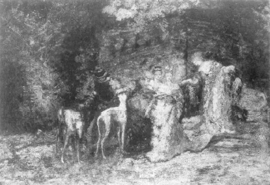 fig. 2
Adolph Monticelli, The greyhounds, c. 1873-75, Toledo Museum of Art been refurbished 80 years earlier by the banker Peixotto, but had since fallen into ruin.Ga naar voetnoot8 Whether Van Gogh knew of the park's elegant 18th-century pedigree we do not know, but the half-hidden door adds a note of mystery and the three couples in different postures of courtship a sense of romance that endow the painting with a scent of nostalgia for the rococo. Indeed, it has been pointed out that Van Gogh, who had read the Goncourt brothers' L'art au dixhuitième siècle (1875), valued Watteau's fêtes galantes and was, of course, a passionate admirer of their contemporary reincarnation in the work of Adolphe Monticelli.Ga naar voetnoot9 But although one can draw parallels between Van Gogh's painting and similar scenes by Monticelli in which elegantly dressed figures disport themselves in front of foliated backdrops (fig. 2), Parc Voyer d'Argenson should not be seen as a mere recasting of Monticelli, still less Watteau, in a style | |
[pagina 56]
| |
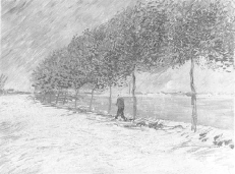 fig. 3
Vincent van Gogh, Road along the Seine near Asnières (F 299 JH 1254), 1887, Amsterdam, Van Gogh Museum (Vincent van Gogh Foundation) loosely derived from neo-impressionism. It is, rather, a painting of very personal expression. Writing to Theo in 1888 Van Gogh referred to Parc Voyer d'Argenson as a ‘jardin avec amoureux’ [594/473], and in that sense it was a prototype for the canvases he would paint in Arles that made much of the association of gardens and lovers. But on its own terms, and specifically in the context of mid-1887, the painting might be read very differently. When Van Gogh chose, not infrequently, to paint figures into his diagonally composed Paris scenes, the design serves to give them a pace and purpose within the picture (fig. 3) By contrast, in Parc Voyer d'Argenson the figures stand back from us, almost as if they were on a stage. A similar effect was achieved in a slightly later painting, made in the summer of 1887 and apparently representing factories at Clichy (fig. 4). This is not merely another suburban landscape, albeit with a less picturesque motif. Again the painting is organised in horizontal bands. Once more there is a couple, this time strolling across the picture space. Above all, the painter distances himself from them. In both these paintings Van Gogh dispensed with his more usual and dynamic diagonal composition for a more theatrical design. In these the painter and spectator are disconnected 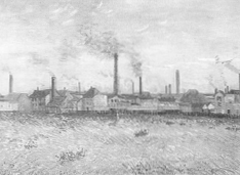 fig. 4
Vincent van Gogh, Factories at Asnières from the quai de Clichy (F 317 JH 1287), 1887, Saint Louis Art Museum 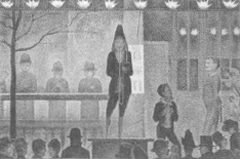 fig 5
Georges Seurat, Parade du cirque, 1887-88, New York, The Metropolitan Museum of Art | |
[pagina 57]
| |
connected from the scene represented, which becomes less a scene observed than a tableau contrived. This process of distancing, non-emphatic as it may be, carries with it a note of melancholy and alienation. At the end of 1887 Van Gogh was confident enough to hang work in the corridors of the Théâtre Libre. Although an informal arrangement, it meant showing alongside Seurat and Signac.Ga naar voetnoot10 Parc Voyer d'Argenson, Van Gogh's ambitious decorative hybrid of neo-impressionism, was the canvas he chose to display. On leaving Paris for Arles in February 1888, his last act as a Parisian painter was, finally, to visit Seurat in his studio. There he would have seen, ready for show at the forthcoming Salon des Indépendants, the neo-impressionist leader's haunting Parade du cirque (fig. 5). Although a nocturne and an entirely different subject, one wonders whether Seurat's painting, which also evinces in the spectator a sense of glum disjunction from the vitality of the city, would have provoked in Van Gogh a sense of distant cousinage with his Parc Voyer d'Argenson. For what makes Van Gogh's painting so fascinating a work is the way its delightful decorativeness is infused with melancholy. | |
A neo-impressionist experiment Cornelia HomburgIn 1887 Vincent van Gogh painted a number of canvases that illustrate his investigation of neo-impressionism. Introduced by Georges Seurat at the Salon des Indépendants in 1886, named by the radical critic Félix Fénéon and effectively promoted by Seurat's friend and collaborator Paul Signac, neo-impressionism quickly became established as an influential avant-garde movement. Anyone who was interested in new art in Paris took notice, and artists either participated or took pains to distance themselves from it. A newcomer to the Parisian art scene who had arrived with a rather limited understanding of contemporary developments, Vincent van Gogh soon recognised the necessity of aligning himself with the avant-garde if he wanted to be considered a modern artist. He began by appropriating stylistic elements of impressionism, lightening his palette and adopting a more spontaneous brushstroke. Impressionism was probably the best starting point for someone who wanted to learn about contemporary art. Many impressionists were exhibiting regularly and their work could be studied at numerous venues.Ga naar voetnoot11 They were well established as modern artists and had generally earned the respect of their younger colleagues. An aspiring painter could benefit from their achievements, but he could not enter their ranks without being considered a mere follower. If one wanted to be seen as a member of the avant-garde, it was necessary to produce something more original. Van Gogh quickly became aware of this dilemma, and neo-impressionism definitely presented a solution. The style offered a new form of expression with regard to colour, brushstroke and content. Van Gogh joined many others in pursuing this opportunity. Like many of his contemporaries, Van Gogh did not care to immerse himself in the more theoretical aspects of neo-impressionism. While early on he had been fascinated by Delacroix's colour theory and had read Charles Blanc's Les artistes de mon temps (1876), as well as Silvestre's | |
[pagina 58]
| |
Eugène Delacroix: documents nouveaux (1864), Van Gogh does not seem to have known the writings of Charles Henry, which were so important for Seurat. It seems that the practical implications of the style were sufficient for him and he applied them as they suited him best. Van Gogh gained access to neo-impressionist ideas through his acquaintance with Paul Signac, whom he met in early 1887. The two artists went painting together in the suburbs of Paris, and Signac, always eager to promote the new credo, would have been an effective teacher. However, Van Gogh never followed Signac fully in terms of technique and never imitated his carefully orchestrated application of small dots. He undoubtedly found the pointillist brushstroke difficult: his more spontaneous, quick manner of working would have made the painstaking application of tiny, regular touches of paint extremely trying. As a consequence there are only a few canvases that show a truly explicit neo-impressionist approach. In the final analysis, however, the impact of the style's basic characteristics on Van Gogh's thinking cannot be underestimated. When the artist began to develop his own ideas about modern art, colour contrast and the deliberate use of brushstroke to intensify a motif from nature became important elements in his painting. Frequent references to Seurat during Van Gogh's stay in Arles are testimony to his influence.Ga naar voetnoot12 Van Gogh's efforts at applying the neo-impressionist touch and intense colour contrast to his own work are perhaps best demonstrated by the highly finished Fritillaries in a copper vase (fig. 6), painted in the spring of 1887. Part of Van Gogh's extensive Paris series of flower still lifes, this painting, with its dramatic orange blossoms against an intensely blue background, well illustrates his exploration of colour contrast and pointillist brushstroke. The Interior of a restaurant (fig. 7) is another attempt by the artist to create a neo-impressionist composition. In this canvas, the green and red complementary colour contrast is the dominant element, but the brushwork already shows the faster, elongated touch Van Gogh would soon begin to use in place of the pointillé advocated by Seurat and Signac. The impatience expressed in the brushwork is underlined by the artist's decision not to use a small stroke throughout, but instead to execute certain elements - such as the legs of the table and the chairs - in a more traditional manner. By contrast, in his painting A suburb of Paris with a man carrying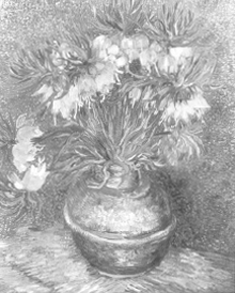 fig. 6
Vincent van Gogh, Fritillaries in a copper vase (F 213 JH 1247), 1887, Paris, Musée d'Orsay a spade (F 361 JH 1260), the artist focused more on pointillist paint application than on creating an intense colour contrast. Van Gogh's most ambitious canvas in the context of his experimentation with neo-impressionism is his Parc Voyer d'Argenson, also executed in the spring of 1887. This work shows that by now Van Gogh had fully assimilated some of neo-impressionism's most important characteristics and was able to incorporate them into his own work effectively. It is also one of the largest works painted in Paris and deserves a prominent place among the canvases of that period. It depicts a park in Asnières, the Parisian suburb where Van Gogh often went painting with Signac or Emile Bernard. He captured the flowering trees of spring and the strolling couples who could frequently be found there. However, the carefully arranged arabesques of the paths, the distribution of tree trunks, and in particular the placement of the three pairs of people - walking, seated and stretched out on the grass - suggest a more deliberately composed layout than could be found in nature. This careful | |
[pagina 59]
| |
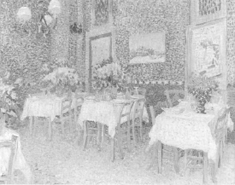 fig 7
Vincent van Gogh, Interior of a restaurant (F 342 JH 1256), 1887, Otterlo, Kröller-Müller Museum arrangement of a landscape is much more typical of compositions by Signac and Seurat. Seurat's compositional approach in A Sunday on the Grande Jatte (1884) (fig. 8) offers an obvious comparison, even though Van Gogh's canvas is of a more modest scale.Ga naar voetnoot13 Van Gogh here created a painting that distinguishes itself clearly from the more spontaneous, impressionistic park scenes that he had done earlier,Ga naar voetnoot14 emphasising instead the organisation and intentional composition characteristic of neo-impressionist canvases. The fact that there are studies for this final composition testifies to this aim.Ga naar voetnoot15 Even though Van Gogh used an elongated brushstroke that allowed for an easier and faster application of paint, the technique also gives the composition a rhythm and directional energy that seems as deliberate as the placement of compositional elements. Van Gogh's choice of a park scene was in a way an obvious one: the urban parks in and around Paris offered a convenient motif, one used by many of his contemporaries. It is also a reference to Seurat's depiction of people relaxing along the banks of the Seine. At the same time, the subject  fig. 8
Georges Seurat, A Sunday on the Grande Jatte (1884), 1884-86, The Art Institute of Chicago attained extraordinary significance for Van Gogh during the course of his career, culminating in the paintings of The poet's garden in Arles, which he made as decorations for the Yellow House. The people in Parc Voyer d'Argenson are not depicted as individuals, but as couples, or as Van Gogh called them: lovers [594/473]. They seem to symbolise Van Gogh's yearning for a partner in his personal life, although they can also be read on a broader level as an expression of his desire for human relationships in general, such as the friendships he hoped to establish with other colleagues, the exchange of ideas and the sharing of artistic ambitions. In Van Gogh's identification of the composition with an emotionally charged content lies a fundamen- | |
[pagina 60]
| |
tal difference to Seurat's large Grande Jatte. Seurat's ironic observation of his characters is dramatically different from Van Gogh's more sentimental approach to his couples. The Parc Voyer d'Argenson was an ambitious undertaking for Van Gogh. It exudes confidence with its modern use of colour, new type of brushwork and subject matter, all of which Van Gogh explored during his sojourn in Paris. It also exemplifies his aspirations for a career as an avant-garde artist. He presented it in a small exhibition in the foyer of the Théâtre Libre, together with works by Seurat and Signac. While the general public would not have known this small venue, it was recognised in art circles as a showplace for the avant-garde, and offered an opportunity for the initiated to see the newest developments in painting. For Van Gogh this installation was the first occasion on which he could demonstrate his assimilation of the latest ideas in painting and it served to associate him publicly with prominent members of the avant-garde. He must have considered this venue as a decided step upward from the restaurant exhibitions he himself had organised in 1887, even though those displays had included many more canvases. Van Gogh's inclusion in the Théâtre Libre show indicates that he had gained access to the neo-impressionists and was, at least to a certain extent, accepted by their leaders. While we do not know if he showed other paintings at the same time, Parc Voyer d'Argenson was undoubtedly a prominent example of his latest work. The size and finish of the composition would have suggested artistic confidence, while the deliberate use of new stylistic elements would have proclaimed the artist's avant-garde leanings. Van Gogh must have considered this presentation a fitting conclusion to his sojourn in Paris. With his departure for Arles he began to develop his own artistic identity, one that he hoped would not only allow him to join the ranks but make him stand out among his contemporaries. | |
Derangement of clouds Richard ShiffDuring the war years of the early 1940s, a half-century after Vincent van Gogh's death, critics continued to debate the aesthetic merit of his art. Was it absolute, to be appreciated under all conditions? Or did people suffering social disorder identify with Van Gogh's jarring style because they recognised a parallel disorder and pain? The American Clement Greenberg related Van Gogh to two older contemporaries, Paul Cézanne and Henri ‘Le Douanier’ Rousseau, each of whom he considered comparably alienated and even ‘deranged.’ According to Greenberg, the public appreciated the look of these artists' paintings despite - or rather because of - an expressive directness that verged on primitiveness.Ga naar voetnoot16 This was not necessarily an association the artists had encouraged, yet all three shared with primitivistic practices a technique that revealed every feature of its organisation. Reporting on the Van Gogh exhibition at the Wildenstein Gallery in New York in 1943, Greenberg had invoked ‘the emphatic physical presence of the [primitive] work of art that exposes to full view [...] its means of effectuation.’ He added immediately: ‘With Van Gogh there also enters the power of an original temperament frustrated by its rupture with [the] world of logic, competition, and compromise.’Ga naar voetnoot17 Van Gogh's look of primitivism resulted from his excessive, frustrated emotion, his ‘derangement’; channelled into art, this became his ‘genius.’ It was not to be confused with his skill.Ga naar voetnoot18 Greenberg countered the opinion that Van Gogh had been a flawed, even amateurish technician (an ‘untrained hand,’ said Roger Fry), whose art had been saved by the force of genius, over which he might exercise no more control than over his hyperactive brush.Ga naar voetnoot19 Instead, Greenberg argued that the painter's frustrated temperament, not some technical insufficiency, had put his control at risk: ‘Van Gogh became too obsessed by the pattern glimpsed in nature. The frenzied insistence with which he tried to reproduce this pattern in his separate brush strokes and give it the same emphasis over every tiny bit of canvas resulted in pieces of violent decoration, the surfaces of which had been ornamented instead of painted into a picture.’Ga naar voetnoot20 It was typical of Greenberg to hinge his analysis on a technical observation: ‘separate brush strokes [...] same emphasis.’ | |
[pagina 61]
| |
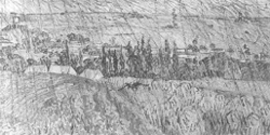 fig. 9
Vincent van Gogh, Landscape in the rain (F 811 JH 2096), 1890, Cardiff, National Gallery of Wales At issue was the marking, caught between the constraints of naturalism and the ornamental excesses of temperament. Perhaps the Landscape in the rain of 1890 (fig. 9) presents Van Gogh's emotionalised marking at its most extreme. Yet his rendering is also quite literal: in our own naive and primitive experience, we perceive falling drops of rain as linear traces, just as the painter represented them, distributed with ‘the same emphasis’ throughout. Van Gogh's attempt at ‘rain’ may have been inspired by Japanese prints and a sense of a Japanese ideal of nature; but his actual rendering, an instance of his ‘frenzied insistence,’ might also suggest alienation (as it did to many commentators). ‘Van Gogh's shortcomings as an artist,’ Greenberg wrote, ‘are a translation into another language of those that belonged to him as a human being.’ Technique was the symptom, not the disease - the ‘mistakes [were] of temperament, not of craft.’Ga naar voetnoot21 Given this distinction between temperament and craft, Van Gogh's Paris paintings, such as Parc Voyer d'Argenson, acquire particular significance. For Greenberg, these works ‘unsettle[d] some of the usual notions’ by demonstrating Van Gogh's capacity for self-control.Ga naar voetnoot22 ‘The artist functions best in the company of other artists,’ the critic would note. This was indeed the situation in Paris in 1887, where Van Gogh developed new techniques through absorbing the work of Claude Monet, Camille Pissarro, Georges Seurat, Paul Signac and others. In worldly Paris - a place of ‘logic, competition, and compromise’ - Van Gogh ‘most firmly controlled his feelings for the sake of pictorial ends.’Ga naar voetnoot23 Expressive ‘feelings’ versus descriptive ‘pictorial ends’: the tension between these two elements appears in the performative organisation of Van Gogh's mark of paint, which may have forever threatened to accede to his inflamed temperament. Greenberg implied, however, that the threat was diminished by the ‘Paris’ mark Parc Voyer d'Argenson, characterised by its relatively regular stroke. Regularity can amount to ‘violent decoration’ but can also constitute a logical, compromising construction. Is the mark in Parc Voyer d'Argenson more constructive than either descriptive or expressive? The amorous human figures are surely cases of description: their features and accoutrements are indicated by strokes that trace aspects of the form, such as the curving brim of a hat or the rigid struts of a parasol. But what of Van Gogh's flowering trees and his sky? In these situations, his stroke was less specific and more repetitive, seemingly tempering his quick inventiveness with discipline. In the trees, reddish marks indicate blossoms, but without much textured differentiation from the green foliage. The patterning of marks gives the sense of | |
[pagina 62]
| |
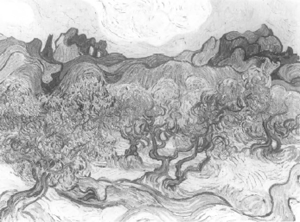 fig. 10
Vincent van Gogh, Olive trees in a mountain landscape (F 712 JH 1740), 1889, New York, The Museum of Modern Art flowering without necessarily indicating where a particular flower actually existed or how many one might have been able to count. This generalised effect is typical of the impressionism of the 1880s. It indicates that Van Gogh was interpreting, assimilating and controlling techniques that others had only recently developed. And the sky? There, vigorous but repetitive strokes slant more or less in the same direction. Their internal distinctions are of colour, ranging from blue to greyish blue to white. Are there any clouds? Certain areas are predominantly bluish; others are quite greyish, a conventional colouring for clouds set against a blue sky. Despite this cloud-colour, the patterning of strokes, the rhythmic movement of Van Gogh's hand, generates no cloud-shape. It is as if Van Gogh took the shape that pictorial convention might have assigned to clouds and dispersed it like a vapour throughout his constructed sky, signifying the missing form by a distribution of colour but not by the precision of line. If his putative clouds lose all shape and lack any obvious ‘pictorial end’ (Greenberg's term), a different feature of their experience emerges - their atmospheric flux. Having no boundaries, the cloud-colour appears to shift within the pictorial sky, which it simultaneously constitutes. Ironically, this degree of formlessness, unusual in pictures, is common in the clouds of nature, ever changing. A curious gap thus opens between Parc Voyer d'Argenson and Van Gogh's many works that display delineated clouds, such as Olive trees in a mountain landscape of 1889 (fig. 10), painted at Saint-Rémy. Greenberg regarded the linear type of rendering as less constrained, more emotional, less of a compromise with Parisian impressionism and neo-impressionism. Yet the Paris style presents its own interpretive strangeness. Van Gogh's Parisian clouds acquire no secure physicality, whereas the mark that renders them is intensely physical, becoming denser and whiter (therefore brighter) where it meets the trees. What might its insistent slant mean, if anything? Is it merely a direction of the brush comfortable for the artist? The materiality of the paint stroke and its slant cause me to think - naively, fantastically, primitively - of rain. Yet Van Gogh's sky must be relatively clear: a woman is carrying a parasol, not an umbrella; and sunlight seems to illuminate her companion's extended arm. This ‘rain,’ then, is a raining down of strokes, of gestures. Van Gogh's gesture describes neither an object nor a condition; the sky is not precisely cloudy, not precisely sunny, and the ‘raining’ is not rain. Nor does the gesture construct a form. If we scan from one local area of sky to another, the view simply changes; the slanting strokes and the colour vary as if to provide the delight of variation. Van Gogh's mark is too directional to be pointillist and better resembles the more casual brushwork of impressionism. It is nevertheless too emphatic to exist within the impressionist paradigm. After his scene has been viewed, Van Gogh's mark remains active, evoking the force of his hand - both its skilled control and its extremes of ‘deranged’ feeling - in Paris as much as in Arles, Saint-Rémy, or Auvers. | |
[pagina 63]
| |
Love in a cold climate Linda NochlinI think this is the saddest painting of love that I have ever seen. There is a little fence in the right foreground that sets the tone - cutting off, enclosing, circumscribing. Although it is a big picture - I once saw it but now know it only in reproduction - it doesn't look big, but rather small and melancholy in its adamant refusal of space, air, breathing room. Rather than reiterating the sensuous, pleasurable mood of Watteau's Embarkation for Cythera or the dulcet tone of his fêtes galantes, Van Gogh lays before us a garden of repression, a park of frustration. Are these indeed meant as lovers at different stages of their affair, on the model of Watteau? Are they in fact moving from separation (in the rear) to arm-in arm strolling (in the right centre) to ‘fulfilment’ (centre left)? Perhaps that was what Van Gogh intended, but, as is so often the case with him, his intentions and the actual outcome of the piece diverge markedly. Confronting his park at Asnières, I think less of Watteau or Monticelli, who did similar scenes - or even of the (formally) more apposite Seurat and his Grande Jatte (fig. 8; also a scene of urban recreation in the out-of-doors) - than I do of Cézanne and his sinister Picnic (c. 1870-71, private collection) with its disturbing overtones of estrangement, alienation and perversity. What a depressing painting this is, despite its peppy semi-divisionist brushwork and rather bright colour scale! The weaving paths, though they may give the painting a formal veneer of liveliness, lead nowhere: they are part of a circular argument, as it were. Van Gogh entraps each couple in its particular vacuum of stifled feeling. They are almost faceless. The back couple stare at each other, from a distance, separated by trees. The couple with linked arms march stiffly, as though under duress, given marching orders or going to a funeral. The left-hand couple poses awkwardly, frozen in place as though told to ‘hold it’ by a photographer. Nowhere in this painting does the vital sap of Eros, so brilliantly conjured up by artists from Titian to Renoir to Picasso, flow freely. There are no physical connections made here, certainly no psychic ones. Come to think of it, the idea of Van Gogh as a garden-of-love painter is a bit ridiculous. If he is capable of generating an image of love in pictorial form it is not Eros that is in question, but some form of caritas, of universal charity. Think of his studies of the heads of peasant women for The potato eaters, or his nude drawing of Sien, or later, his apparently affectionate painting of Madame Roulin as La berceuse. These are, in a sense, loving images, but not images of love in action such as he sought, and notably failed, to create in his Parc Voyer d'Argenson. One wonders what drew him to such a subject, so superbly inappropriate to his talents. Of course, artists are continually drawn to utopian subjects, so there is no point in speculating in Van Gogh's particular case. But it is the disparity between result and intention that is so striking here, and so disturbing. |
|

